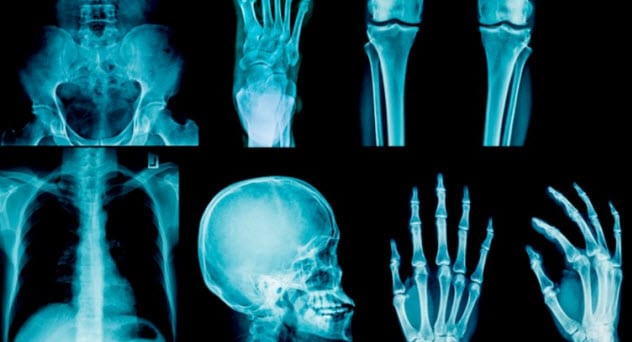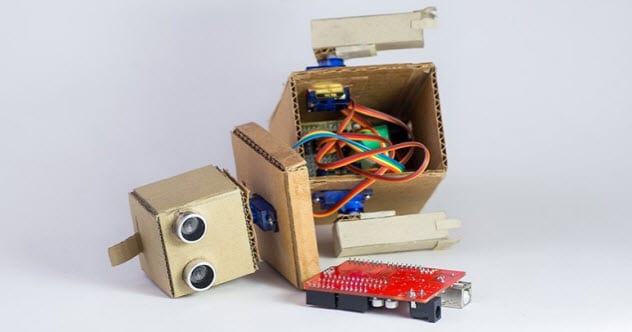 Movies and TV
Movies and TV  Movies and TV
Movies and TV  Health
Health 10 Miraculous Advances Toward Curing Incurable Diseases
 Miscellaneous
Miscellaneous 10 Undeniable Signs That People’s Views of Mushrooms Are Changing
 Animals
Animals 10 Strange Attempts to Smuggle Animals
 Travel
Travel 10 Natural Rock Formations That Will Make You Do a Double Take
 Movies and TV
Movies and TV 10 Actors Hidden in Your Favorite Movies
 Our World
Our World 10 Science Facts That Will Change How You Look at the World
 Pop Culture
Pop Culture 10 Incredible Female Comic Book Artists
 Crime
Crime 10 Terrifying Serial Killers from Centuries Ago
 Technology
Technology 10 Hilariously Over-Engineered Solutions to Simple Problems
 Movies and TV
Movies and TV 10 Movie Adaptions That Brought Popular Songs to Life
 Health
Health 10 Miraculous Advances Toward Curing Incurable Diseases
 Miscellaneous
Miscellaneous 10 Undeniable Signs That People’s Views of Mushrooms Are Changing
Who's Behind Listverse?

Jamie Frater
Head Editor
Jamie founded Listverse due to an insatiable desire to share fascinating, obscure, and bizarre facts. He has been a guest speaker on numerous national radio and television stations and is a five time published author.
More About Us Animals
Animals 10 Strange Attempts to Smuggle Animals
 Travel
Travel 10 Natural Rock Formations That Will Make You Do a Double Take
 Movies and TV
Movies and TV 10 Actors Hidden in Your Favorite Movies
 Our World
Our World 10 Science Facts That Will Change How You Look at the World
 Pop Culture
Pop Culture 10 Incredible Female Comic Book Artists
 Crime
Crime 10 Terrifying Serial Killers from Centuries Ago
 Technology
Technology 10 Hilariously Over-Engineered Solutions to Simple Problems
Top 10 Peculiar Facts About Pain
Cringeworthy paper cuts aside, the realm of pain is packed with freaky facts. There is the horror of the world’s most noxious bush, why flesh-destroying bacteria really hurt, and the family that cannot be hurt. Agony has a sweet side, too. Some pain feels good, and then there is a walk more popular (and crippling) than fire walking.
Things can also get exceptionally weird. There are people who experience the suffering of others, experiments that produce fake agony, and the robots taught to feel pain.
10 Financial Stress Causes Pain

In recent years, researchers noticed a curious thing. As economic insecurity rose, so did complaints of physical discomfort. To see if there was a link, several studies were gathered and analyzed. The umbrella project was thorough: Researchers looked at the lives, worries, and pain levels of thousands of people.
They were divided into six studies that used different methods, but all arrived at the same conclusion. It physically hurts to be financially insecure. Online surveys, consumer panels, and laboratory volunteers faced questions about finances, unemployment, and consumption of painkillers. Some even endured painful tests.
In 2016, the results showed that stress kicked in when income was too low or people feared an insecure future or a lack of control in their lives. Anxiety has similar neural mechanisms to those responsible for pain. This could explain why cash-strapped volunteers reported buying more painkillers during hard times than those who felt financially secure.[1]
9 Why Pain Feels Good

Some people enjoy eating chilies so hot that it sets their sinuses on fire. Others love painful sex. In 2013, researchers wanted to know why agony can feel good. They found 18 volunteers willing to suffer. The participants were given two tests plus a warning before having their arms burned.
The first test only zapped them with two degrees—no pain and heat equal to holding an uncomfortably hot mug. During the second test, they were mildly stung (the hot mug level) or given very painful burns. The volunteers rated the “mug” as worse during the first session but pleasurable during the second.
To understand this change, researchers studied MRI scans. Throughout both experiments, the participants’ brain activity had been recorded. Surprisingly, when volunteers knew they had avoided something worse (like the painful burn), the brain dulled its pain region and heightened the areas for pain relief and pleasure.
That was why a bad experience from the first test felt good in the second. Somehow, after expecting the worst, feeling emotional relief made the weaker burn pleasurable.[2]
8 Hijacked Pain Receptors

Several strains of bacteria cause the terrifying “flesh-eating disease,” but Streptococcus pyogenes is the most rampant. Technically called necrotizing fasciitis, the deadly disease comes with a high mortality rate. One would expect a gruesome condition like fasciitis to hurt. In fact, it is excruciating. The real reason behind the agony was found in 2018, and it was scary.
With a freaky intelligence, the bacteria hijacks the victim’s pain receptors to escape their immune system. It starts during the early stages of infection when S. pyogenes releases a poison. The toxin manipulates neurons to unleash pain and a peptide that stops the immune system from attacking the bacteria. This allows the disease to flourish.
Oddly, a beauty fad might help. Scientists turned to Botox (Botulinum toxin), a protein injection that smooths out wrinkles. In infected mice, Botox blocked the hijacked nerve signals from interfering with the immune system.[3]
7 Swearing Is A Painkiller

All languages have one thing in common—scarlet words. Cussing is as old as the mountains, and there might be an interesting reason behind its longevity. Swearing, which is a common response to injuries, boosts pain tolerance.
In 2009, scientists warily considered the possibility. Since sailor-speak often exaggerates pain, they thought it would lower tolerance instead. Around 64 volunteers agreed to find out the truth. All they had to do was hold their hands in ice water for as long as possible.
The first time, they swore until the room’s paint peeled. During the second time, they had to repeat one word with which they would describe a table. Something normal, like “wooden” or “furniture.” To the surprise of the researchers, cussing kept the participants’ agonized hands underwater for longer.[4]
A plausible theory suggested that cursing is an aggressive act. This could activate the fight-or-flight response, a survival mechanism that allows greater pain resistance.
6 Thermal Grill Illusion Twist

The thermal grill illusion is a pain experiment. A volunteer’s middle finger is chilled to around 20 degrees Celsius (68 °F). At the same time, the ring and index fingers are warmed to 40 degrees Celsius (104 °F).
This combination produces a burning heat in the middle finger. This illusion happens as the brain tries to understand three fingers simultaneously sending signals about pain and different temperatures. The “heat” in the cold finger happens when the outer fingers with their real heat block the skin’s cooling receptors. These receptors usually lessen pain. But thus overwhelmed, the brain thinks the cold middle finger is burning.
In 2015, scientists found that the brain also became confused when volunteers crossed their fingers. When the middle finger crossed over the index finger, the burning subsided. When the index finger was cooled down, the middle and ring fingers received heat, and the middle once again crossed over the index, the burning became worse.[5]
5 Mirror-Touch Synesthesia

Human senses can overlap. This phenomenon is known as synesthesia. Some people taste words. Others experience color with sound or when reading words.
A pain-related version is called mirror-touch synesthesia. Physical contact ignites certain brain regions. When observing another person being touched, the viewer’s brain activates similar areas. This is normal for everybody. In those with mirror-touch synesthesia, this mechanism is overactive. They actually feel what they see.[6]
When seeing a couple kiss, their lips might tingle. While pleasant sensations are part of this sensory overlap, it must be the most painful type of synesthesia. Even watching violent movies can be a difficult experience.
In 2007, a study discovered something interesting. Researchers asked a group of mirror-touch people to fill out a questionnaire specifically designed to measure empathy. Not only did they score higher than those without the condition, but they were almost super-empathetic. For some reason, they have an unusually intense ability to put themselves in others’ shoes.
4 World’s Most Painful Plant

Forget about taking a gympie bush home. This is no pot plant. Found in the Australian rain forests, this shrub is taller than a man and grows furry leaves soft enough to invite a touch.
Bad idea. The hairs are filled with a mysterious poison. Once touched, they unleash excruciating agony.
A man stung in 1941 had to be restrained for three weeks in the hospital. Another killed himself to escape the pain. A scientist who got stung likened the experience to simultaneously being burned by acid and getting electrocuted.[7]
The sadistic shrub can torture a victim for up to six months, which is how long the hairs can stay under the skin. When the area is pressed or washed, the pain flares up again. Even museum workers have to be careful. Samples stored well over 100 years ago can still cause burns.
Merely standing near a gympie is asking for trouble. After 20 minutes, something causes violent sneezing, nosebleeds, and possible respiratory trauma. It is so noxious that scientists working in close proximity to the bush must regularly replace their face masks. Although never proven, a likely theory suggests that the hairs can become airborne.
3 Family With No Pain

For years, scientists were dumbfounded by the Marsili family from Italy. They do not experience pain like the rest of humanity. Broken bone? Seconds later, they feel fine. Fractures go unnoticed. For at least three generations, the Marsilis felt neither pain when burned nor discomfort when sick.
There was a downside. Sometimes, they never realized a serious injury had taken place. The person would continue with his daily life, which delayed treatment and aggravated the condition.
In 2017, blood samples revealed the cause. A gene called ZFHX2 carried a mysterious mutation. To test the gene, two groups of mice were bred to either have the mutation or lack ZFHX2 completely. Those with the missing gene had a higher pain tolerance, but the mice with the mutation felt no pain at all.
The mutation remains poorly understood but could play a role in the disruption of pain signaling. Scientists aim to unravel this mystery and use the information to develop relief for patients with chronic pain. Speaking of being cured, the Marsilis said that they would refuse the offer to experience pain like everyone else if researchers find a way to reverse the rare syndrome.[8]
2 LEGO Walking vs. Fire Walking

A recent craze is LEGO walking. Similar to fire walking or strolling over glass, a person must walk barefoot over a bunch of toy bricks. The colorful challenge is highly popular at events, workshops, and entertainment outlets. This is odd considering that walking over the blocks hurts more than doing a fire, glass, or ice walk. Russell Cassevah found this out the hard way.
In 2018, he entered the Guinness World Records after completing the world’s longest LEGO walk. After limping an incredible 834 meters (2,737 ft), Cassevah received a certificate and a medic for his bleeding feet. Nobody has tried to break the record since.
Toy bricks may sound safer, but hot coals cannot burn when properly prepared and the walker moves at a quick pace. Similarly, glass walks are designed to avoid cuts. The shards are small and strewn in a thin layer, allowing walkers to flatten them safely.
However, a LEGO walk cannot flatten out. The bricks shift under a walker’s weight, stabbing exceptionally hard edges into the 200,000 receptors found in the foot. This unhappy combination is the reason why stepping on even a single LEGO brick can be excruciating.[9]
1 Robots That Feel Pain

In 2016, scientists crossed another threshold in robotics. The development—robots capable of experiencing pain—could save human lives. Robots that recognize sources of pain can warn people who are nearby that they might be in danger.
Agony-weary equipment could also minimize repair costs. Pain is a warning system. (Hey person, stop running, you just broke your leg.) This same response can tell a robot to stop working when there is a threat to its system, preventing the costly damage from blundering on.
To do the job, researchers developed an artificial nervous system capable of sensing and reacting to things that cause pain. Robots that experience pain exactly like humans are still a distant dream.
However, the 2016 prototype was impressive. It was a robot arm fitted with a fingertip. The latter had a sensor modeled on human skin and could recognize pressure and temperature.
Based on the extremity of each (originating from sharp or hot objects), the arm made decisions. Slight pain made the arm retract until the feeling disappeared. Then the robot returned to its original task. Severe pain forced the arm into lockdown mode to await human assistance.[10]
For more peculiar facts about pain, check out 10 Painful Conditions Doctors Think Are All In Your Head and Top 10 Ancient Pain Relievers.








